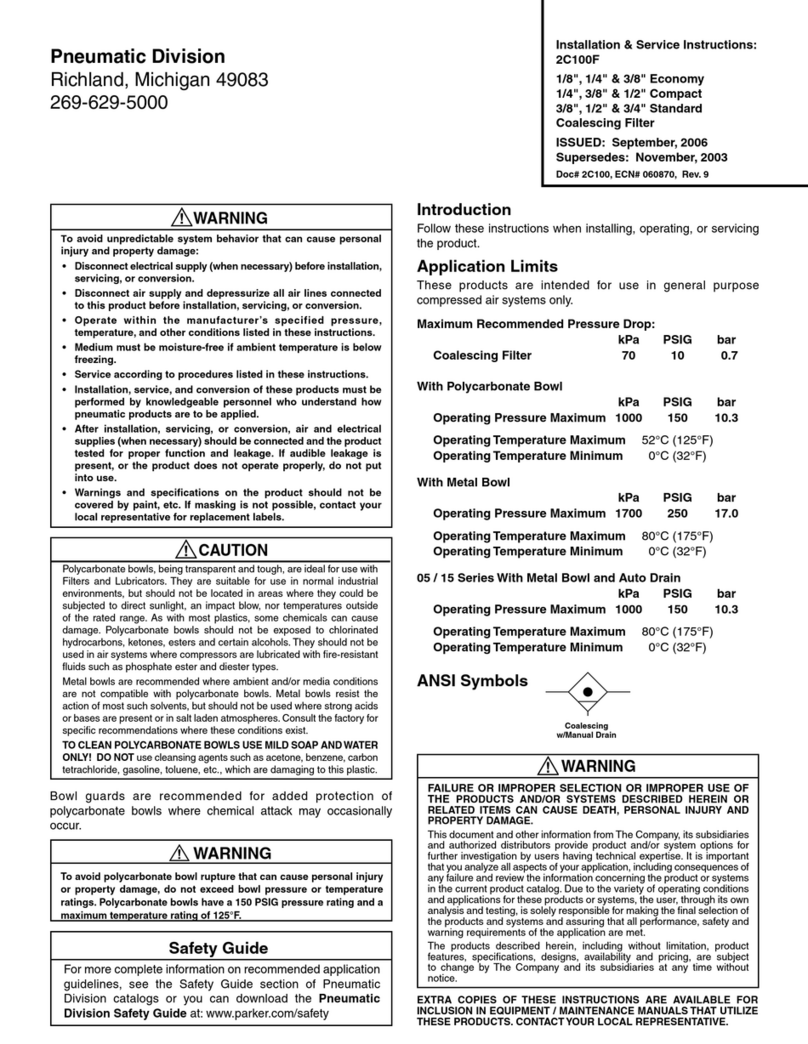
Introduction
Follow these instructions when installing, operating, or servicing
the product.
Application Limits
These products are intended for use in general purpose
compressed air systems only.
kPa PSIG bar
Operating Pressure Maximum 1700 250 17.0
Operating Temperature Maximum 80°C (175°F)
Operating Temperature Minimum 0°C (32°F)
Note: The maximum recommended pressure drop for a particulate
filter is 70 kPa (10 PSIG, 0.7 bar).
Symbols
Filter / Regulator
Installation
1. The filter/regulator should be installed with reasonable
accessibility for service whenever possible – repair service
kits are available. Keep pipe or tubing lengths to a minimum
with inside clean and free of dirt and chips. Pipe joint
compound should be used sparingly and applied only to
the male pipe – never into the female port. Do not use
PTFE tape to seal pipe joints – pieces have a tendency to
break off and lodge inside the unit, possibly causing
malfunction. Also, new pipe or hose should be installed
between the filter/regulator and equipment being protected.
2. The upstream pipe work must be clear of accumulated dirt
and liquids.
Installation & Service Instructions:
2FR300D
1" Series
Filter / Regulator
ISSUED: October, 2003
Supersedes: April, 2003
Doc.# 2FR300, ECN# 030539, Rev. 8
!
WARNING
Product rupture can cause serious injury.
Do not connect regulator to bottled gas.
Do not exceed maximum primary pressure rating.
3. Select a filter/regulator location as close as possible to the
equipment being protected.
4. Install filter/regulator so that air flows in the direction of
arrow on body.
5. Install filter/regulator vertically with the bowl drain mechanism
at the bottom. Free moisture will thus drain into the sump
(“quiet zone”) at the bottom of the bowl.
6. Gauge ports are located on both sides of the filter/regulator
body for your convenience. It is necessary to install a gauge
or socket pipe plugs into each port during installation.
Operation
1. Both free moisture and solids are removed automatically by
the filter.
2. Manual drain filters must be drained regularly before the
separated moisture and oil reaches the bottom of the baffle
or end cap.
3. The filter element should be removed and replaced when
pressure differential across the filter is 69 kPa (10 PSIG).
4. Before turning on the air supply, turn the knob
counterclockwise until compression is released from the
pressure control spring. Then turn knob clockwise and adjust
regulator to desired downstream pressure. This permits
pressure to build up slowly in the downstream line.
5. To decrease regulated pressure settings, always reset from
a pressure lower than the final setting required. Example,
lowering the secondary pressure from 550 to 410 kPa (80
to 60 PSIG) is best accomplished by dropping the secondary
pressure to 350 kPa (50 PSIG), then adjusting upward to
410 kPa (60 PSIG).
6. When desired secondary pressure settings have been
reached, push the knob down to lock this pressure setting.
Service
Caution: Disconnect or shut off air supply and exhaust
the primary and secondary pressures before servicing
unit.Turning the adjusting knob counterclockwise does
not vent downstream pressure on non-relieving
regulators. Downstream pressure must be vented
before servicing regulator.
Note: Grease packets are supplied with kits for lubrication of
seals. Use only mineral based grease or oils. Do not use
synthetic oils such as esters. Do not use silicones.
Note: After servicing unit, turn on air supply and adjust
regulator to the desired downstream pressure. Check
unit for leaks. If leakage occurs, do not operate - conduct
repairs and retest.
WARNING
To avoid unpredictable system behavior that can cause personal
injury and property damage:
• Disconnect electrical supply (when necessary) before
installation, servicing, or conversion.
• Disconnect air supply and depressurize all air lines connected
to this product before installation, servicing, or conversion.
• Operate within the manufacturer’s specified pressure,
temperature, and other conditions listed in these instructions.
• Medium must be moisture-free if ambient temperature is below
freezing.
• Service according to procedures listed in these instructions.
• Installation, service, and conversion of these products must be
performed by knowledgeable personnel who understand how
pneumatic products are to be applied.
• After installation, servicing, or conversion, air and electrical
supplies (when necessary) should be connected and the product
tested for proper function and leakage. If audible leakage is
present, or the product does not operate properly, do not put
into use.
• Warnings and specifications on the product should not be
covered by paint, etc. If masking is not possible, contact your
local representative for replacement labels.
WARNING
FAILURE OR IMPROPER SELECTION OR IMPROPER USE OF THE
PRODUCTS AND/OR SYSTEMS DESCRIBED HEREIN OR RELATED
ITEMS CAN CAUSE DEATH, PERSONAL INJURY AND PROPERTY
DAMAGE.
This document and other information from The Company, its subsidiaries and
authorized distributors provide product and/or system options for further
investigation by users having technical expertise. It is important that you
analyze all aspects of your application, including consequences of any failure
and review the information concerning the product or systems in the current
product catalog. Due to the variety of operating conditions and applications
for these products or systems, the user, through its own analysis and testing,
is solely responsible for making the final selection of the products and
systems and assuring that all performance, safety and warning requirements
of the application are met.
The products described herein, including without limitation, product features,
specifications, designs, availability and pricing, are subject to change by The
Company and its subsidiaries at any time without notice.
EXTRA COPIES OF THESE INSTRUCTIONS ARE AVAILABLE FOR
INCLUSION IN EQUIPMENT / MAINTENANCE MANUALS THAT UTILIZE
THESE PRODUCTS. CONTACT YOUR LOCAL REPRESENTATIVE.
Pneumatic Division
Richland, Michigan 49083
269-629-5000
!
!
!























